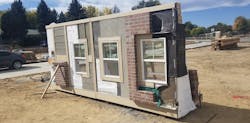Construction Quality Assurance Program Fundamentals
When it comes to managing construction quality, there are a few fundamentals that make the difference between consistent execution of properly built assemblies and what feels like trying to keep a dozen plates spinning on sticks. It won’t happen overnight, and following these steps will take time and effort, but the results will last for years. Here is the template:
- Clear and concise documentation
- Effective communication
- Ongoing inspection
RELATED
- What Is the Cost of Quality Construction?
- 2022 NHQA Winners: 3 Home Builders Committed to Better Business and Operational Excellence
- Why Quality Matters in Booming Times
Clear, Concise Documentation to Ensure Construction Quality
If instructions to achieve a given standard of completion and quality are either vague or poorly written, the execution will be inconsistent.
There are a dozen ways to do just about anything, and they aren’t all equal in their results. As the home builder, it’s essential that you take the time to think through every system and assembly to establish how you want it to be done—with details and preferably with illustrations, as well.
These explicit expectations then become a set of construction standards for your company and therefore must be referenced completely and clearly in your scopes of work and building plans.
When a trade partner signs a contract, the standards must be thoroughly communicated and agreed upon, and the trade must then be held to those standards during construction.
Effective Communication About Construction Quality
While most trade partners appreciate help communicating your standards to their field crews, most also work for other builders that likely do things differently. That’s why clear illustrations and detailed instructions (preferably bilingual, if needed) go a long way toward ensuring everyone is (literally) on the same page.
Another effective way to communicate standards is to build mock-up assemblies on the jobsite that show all of the components, layers, different material interfaces, and other key details in cut-away fashion. Any new crew member can examine the mock-up and quickly see exactly how an assembly is expected to go together and with what materials. On-site mock-ups also serve to refresh a trade team that may be returning to your job after working for another builder.
Ongoing Inspection for Quality on the Jobsite
The adage “you get what you inspect” is an accurate statement, but you need more than a third-party inspection company to make it effective. Your project managers or superintendents must know your standards inside and out and hold trades accountable to them on an ongoing basis. Converting the illustrated construction standards into quick reference checklists (in print or digital) helps the construction staff quickly evaluate each assembly and is a great tool for communicating with trades about any anomalies that require attention.
To drive home consistency, the construction standards become your bible for how your homes are to be built. Trades must understand their responsibility in executing these standards (and there’s no better education than losing time and money having to redo them to meet an expectation). Don’t let anything slide. The more consistent your expectations and inspection of them, the more consistent the trades will become in executing according to your standards.
Get your construction documents aligned to clearly communicate your construction standards and enforce their correct execution through a rigorous inspection protocol. In time, your company will be building with consistency to the highest standards you demand and expect.


